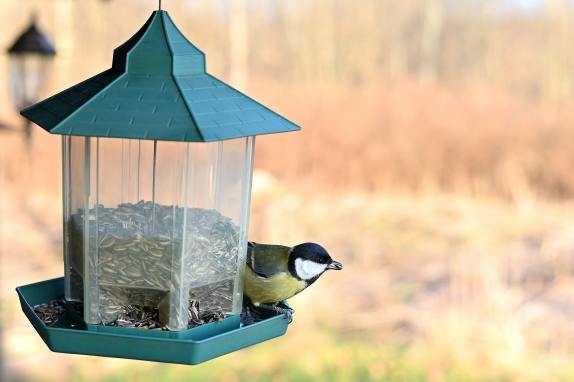
Posted May 1st 2020
How Feeding the Birds can Supplement Conservation Efforts

Posted May 1st 2020
How Feeding the Birds can Supplement Conservation Efforts
You have probably heard the phrase “Don’t feed the bears,” at least once in your life, but how about the phrase, “don’t feed the birds?” And although feeding the birds seems like a sensible way to help populations recover, and bird feeders are welcome additions to most backyards, maybe you’ve also heard that experts advise against feeding your feathered friends.
According to an article published by Audubon, there are a whole host of risks associated with feeding birds. As our knowledge of bird conservation grows more frequent, so too does our awareness for how we can help birds. Birders must carefully consider the time of year, bird species, type of food, and population status before they start handing out seeds or hanging up bird feeders for backyard birds.
But, before you renounce all bird-feeding activities, Julian Avery, assistant research professor of Wildlife Ecology at Penn State reinforces the idea.
She remarks that learning safe bird-feeing practices can actually “promote healthy interactions that can inspire future generations to care about conservation.” So, it is perfectly fine to continue feeding birds as long as we can commit to proper feeding practices that protect populations from harm.
In fact, in addition to using Feather Friendly® bird deterrent window markers, participating in local bird counts, planting native plans, and supporting bird-friendly bylaws and legislations in your area, feeding the birds is just one way you can supplement your conservation efforts.
How Does Feeding Birds Contribute to Bird Conservation?
You may wonder whether your bird feeder or sunflower plants make a difference to the health of local birds. And, while some experts disagree on the effects that regular feeding has on bird populations, they do agree that it is generally a good idea to feed birds during times when food is scarce.
The Humane Society recommends providing resources for birds before and after winter, since birds require the most energy when migrating and breeding. Providing extra food for birds will increase their chances of survival, and may, according to an article in The Biology Letters, also influence the success of spring breeding.
Providing native plants and a nutritionally balanced diet can encourage birds to feed and nest in specific areas. And, in some cases, bird populations are entirely dependent on winter feeding. Julian Avery notes that the population of Anna’s Hummingbirds in British Columbia, which remains in the province through winter, is dependent on feeders for its survival.
It’s no secret that bird survival is dependent on habitat. So, food scarcity can drive native birds out of their natural habitats. This is not just dangerous for birds, but for the environment since birds play a role in pest control, distribution of seeds, and pollination.
Different species and behaviours help maintain ecological balance. And, like the Anna’s Hummingbird, most birds require highly specific diets to benefit from regular feeding. Since birds have a relatively short window to find territory, mate and breed, food can assist birds during mating and breeding season.
Best Feeding Practices for Birds
There’s no doubt that feeding birds is a rewarding activity. As we get deeper into spring, experimenting with different types of feeders, and their placement, can bring a variety of beautiful birds into your backyard. But, before you bust out your bird feeder, we’ve collected a few best practices that you can follow to give your birds the best possible feeding experience.
1. Consider Local Species Before Purchasing Bird Seed
Whether you’ve just started feeding the birds or have an established colony of yearly feeders, you must take the time to research the diets of your local birds. For example, Safflower seeds are a favourite for cardinals, chickadees, and sparrows, but aren’t a good choice if you’re trying to provide food for a local hummingbird population. All About Birds provides a basic list of seeds that are a great starting point.
All About Birds also recommends that Birders avoid purchasing seed mixes that contain added fillers, like red millet or oats, which birds pick through. Be aware of how attractive birdseed is to other species as well, and stay away from anything that might attract racoons, bears, squirrels, or other animals.
Always consider how different birds will interact with each other at the birdfeeder: some species of birds are more dominant and will become territorial over food!
2. Clean Your Feeders!
Unfortunately, feeding birds can sometimes cause them to get sick. Deadly parasites and pathogens are responsible for widespread outbreaks among feeding bird populations.
Feederwatch recommends that homeowners clean their bird feeders regularly, and take care to swap out old seed for fresh seed, since weather conditions, seed type, and even birds using the feeders can pass along parasites that will make other birds sick.
If you do maintain a bird feeder year-round, use a bottle brush to scrub the feeder with dish detergent, and then soak the feeder in a sanitizing solution of vinegar and water for an hour.
You should leave the clean feeder to dry in the sun. Make sure your feeder is completely dry prior to filling. You may even use separate feeders with different seed types to prevent varying species from congregating at the same bird feeder.
3. The Placement and Type of Bird Feeders
There’s no one-size-fits-all bird feeder out there! Choosing the right feeder type is essential for providing food to your local birds. Some species of bird are ground feeders and will not use a feeder that’s elevated off the ground.
If you’re trying to attract larger bird species, consider buying a large hopper feeder that will accommodate their size. Different feeder styles will also have different features and are designed to keep seeds dry and accommodate specific types of species.
Once you do decide what style feeder is best for your local birds, you’ll want to make sure you position the feeder in a way that keeps the birds safe. Feeders that are out in the open, and not close to any bushes, trees, or shrubs, aren’t ideal for birds that prefer to feed in some sort of shelter.
It’s recommended that you place the feeder about twelve feet away from foliage so that birds have a safe place to retreat to if they feel threatened. Be mindful about how high the feeder is off of the ground, and whether or not there are cats in your area. Never place feeders close to windows, and make sure to use bird-friendly window film or markers to prevent window collisions.
Bird-Friendly Feeding in Action!
Let’s take a look at a common North American Bird species to determine the best type of food and feeder for them, and how we can amplify their food supply using native plants.
The Dark-Eyed Junco is one of the many species you’re likely to see in your backyard. Although Juncos are generally ground feeding-birds, they are known to use feeders, too. The Junco’s diet mainly consists of seeds, and two possible sources of food are rapeseed and white millet, but you can put out black sunflower or peanuts for them. Juncos forage on the ground so they’ll eat either scattered seed or seeds that are in a low feeding tray.
If you do decide to ground feed your juncos, be conscious of the amount of seed you lay out: excess seed can spoil over time. And, as always, be leery of outdoor cats and other predators that might attack ground-feeding birds.
Attract juncos by planting various types of conifer and letting grasses seed and let one section of your yard get slightly overgrown: juncos will seek out insects under leaves and fallen logs and use long grasses for their nests.
Make a Few Bird Friends This Season
You can establish a colony of feeding birds year after year by practicing safe feeding. A steady supply of food can supplement feeding, breeding, and mating rituals, and help birds survive during times of ecological or physical stress.
Birds that have returned from a long migration must act quickly to restore their energy and establish their territory, so a backyard that provides birds with ample shelter and food from native plants and your feeders can help populations thrive.
We’re committed to providing resources, tools and education on how you can start your bird conservation journey, including Feather Friendly® bird deterrent DIY tape, so that you can protect feeding birds from window collisions all year long. Contact us or check out our residential page for more tips and information!
Partners
We are honoured to form partnerships with organizations who demonstrate
an ongoing commitment to bird conservation.



